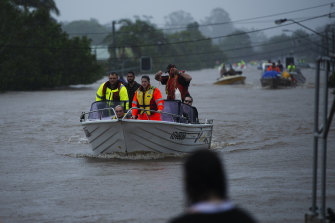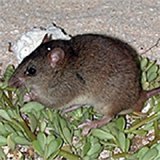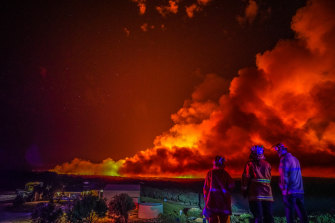Why it matters
- Australia is suffering greater impacts from climate change than any other advanced economy
- There will be a fourfold rise in heatwaves if the planet warms by 3 degrees
- The rise in weather and climate extremes has already led to “some irreversible impacts as natural and human systems are pushed beyond their ability to adapt”
Normal outdoor activity across much of northern Australia could become potentially fatal due to the risk of heat stress, much of the Great Barrier Reef will likely die and snowfields will shrink or disappear under climate change scenarios laid out in a blockbuster United Nations report.
Flash floods from high intensity rainfall are already the nation’s most expensive disasters, averaging $8.8 billion per year, and this is set to increase, the report said.
Severe flooding hits Lismore in northern NSW in the worst flood ever recorded for the town on Monday. Credit:Elise Derwin
It confirms earlier warnings that Australia is suffering greater impacts of climate change than any other advanced economy, and it shows that efforts to adapt to warming are not keeping up with the changes.
Describing the report as an “atlas of human suffering” in a press conference late on Monday night, Australian time, United Nations Secretary General Antonio Guterres said it revealed a “criminal” abdication of leadership around the world.
“Nearly half of humanity is living in the danger zone now, many ecosystems are at the point of no return now, and unchecked carbon pollution is forcing the world’s most vulnerable on a frog march to destruction now,” he said,
UN Secretary-General Antonio Guterres described the report as an “atlas of human suffering”.Credit:AP
“The facts are undeniable. This abdication of leadership is criminal. The world’s biggest polluters are guilty of arson of our only home.”
Mr Guterres said the report revealed two core truths: that coal and other fossil fuels were “choking humanity”, and that swift action to reduce emissions and plan for adaptation could still spare millions from suffering.
“Only 20 governments have agreed to stop funding coal abroad. They must now urgently do the same at home and dismantle their coal fleets,” he said. “Those in the private sector still financing coal must be held to account.”
He said oil and gas giants were also on notice, saying organisations could not claim to be green while having plans and projects that would undermine 2050 net zero targets and that ignored the major emission cuts that must occur in the next decades.
The key risks for Australia
Australia is already at the forefront of extinctions likely attributable to climate change, having lost the Bramble Cay Melomys from its Torres Strait Island home due to sea-level rise in 2016 and a white sub-species of the lemuroid ringtail possum from Queensland, which disappeared after heat waves in 2005.
Should temperatures rise between 1.5 and 2 degrees above pre-industrial levels the frequency of heatwaves will increase by 85 per cent. Heatwaves will rise fourfold if the planet warms by 3°C. Under this scenario some parts of northern Australia would become virtually unlivable by the end if the century, says the report.
Deaths caused by heat in Melbourne, Sydney and Brisbane will increase from 142 per year recently to 600 per year over the coming decades if emissions are high, though this could reduce by half on a lower emissions pathway.
The disappearance of the Bramble Cay melomys is the first known mammal extinction to be directly linked to climate change.Credit:State of Queensland
The frequency and severity of fires will increase, with up to 70 per cent more fire weather days by 2050 in some regions if emissions are not cut, along with the replacement or collapse of alpine ash, snowgum woodland, pencil pine and northern jarrah forests.
Not only would Australia experience even more flooding, but it would be hit by the economic shock of supply chains being disrupted internationally by floods overseas.
These are among the findings of Working Group II of the UN’ lead climate body, the Intergovernmental Panel on Climate Change, which has just published its sixth assessment of climate change impacts, the largest study of its kind since 2014, focussing on impacts, adaptation and vulnerability.
Professor Mark Howden, vice chair of the working group and director of Institute for Climate, Energy and Disaster Solutions at the Australian National University, said the report confirms that climate change impacts are continuing to accelerate. While Australian and international governments have stepped up their adaptation efforts, they are not keeping pace with the shifting climate, he said.
Commitments made during the Glasgow climate talks put the world on a warming trajectory of between 2 and 3 degrees, though various reports show we have the capacity to reduce that far more, Professor Howden said.
Firefighters at the scene of the blaze near Margaret River in Western Australia in December.Credit:DFES
The report draws on the work of hundreds of authors and cites over 34,000 published papers, and says that the rise in weather and climate extremes has already led to “some irreversible impacts as natural and human systems are pushed beyond their ability to adapt.”
Increased heatwaves, droughts and floods are already exceeding plants’ and animals’ tolerance thresholds, driving mass mortalities in species such as trees and corals, said a statement from the IPCC secretariat.
These weather extremes are occurring simultaneously, causing complex and cascading impacts that are increasingly difficult to manage and have already exposed millions of people to acute food and water insecurity, it said.
Key risks identified for Australia
1. Loss and degradation of coral reefs and associated biodiversity and ecosystem service values in Australia due to ocean warming and marine heatwaves (very high confidence)
2. Loss of alpine biodiversity in Australia due to less snow (high confidence)
3. Transition or collapse of alpine ash, snowgum woodland, pencil pine and northern jarrah forests in southern Australia due to hotter and drier conditions with more fires (high confidence)
4. Loss of kelp forests in southern Australia and southeast New Zealand due to ocean warming, marine heatwaves and overgrazing by climate-driven range extensions of herbivore fish and urchins (high confidence)
5. Loss of natural and human systems in low-lying coastal areas due to sea-level rise (high confidence)
6. Disruption and decline in agricultural production and increased stress in rural communities in south-western, southern and eastern mainland Australia due to hotter and drier conditions (high confidence)
7. Increase in heat-related mortality and morbidity for people and wildlife in Australia due to heatwaves (high confidence)
8. Cascading, compounding and aggregate impacts on cities, settlements, infrastructure, supply-chains and services due to wildfires, floods, droughts, heatwaves, storms and sea-level rise (high confidence)
9. Inability of institutions and governance systems to manage climate risks (high confidence)
“The scientific evidence is unequivocal: climate change is a threat to human wellbeing and the health of the planet. Any further delay in concerted global action will miss a brief and rapidly closing window to secure a liveable future,” said Hans-Otto Pörtner, Working Group II’s co-chair.
Climate Envoy of the Marshall Islands Tina Stege, a leading voice in global climate diplomacy, said the science of the crisis was now even more clear.
“Failing to adapt to this crisis will cost lives. Failing to provide fair, accessible climate finance will cost lives. Continued dependence on fossil fuels will cost lives. With the consequences of inaction spelled out so clearly, yet again, a failure to act is inhuman and unconscionable.”
Liam Mannix’s Examine newsletter explains and analyses science with a rigorous focus on the evidence. Sign up to get it each week.
Most Viewed in Environment
From our partners
Source: Read Full Article




